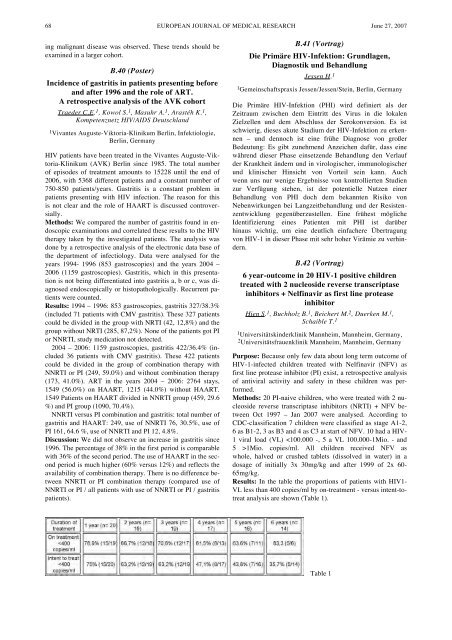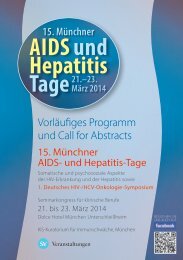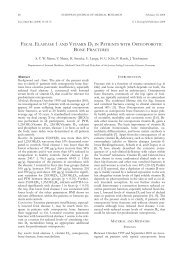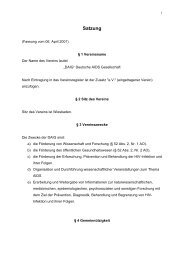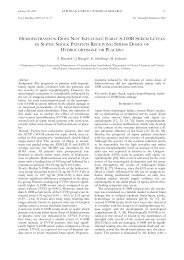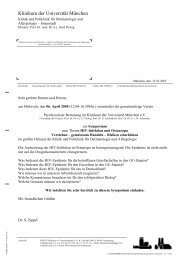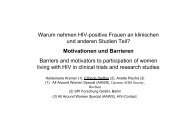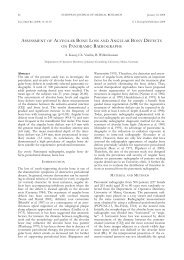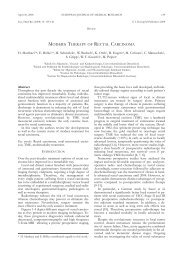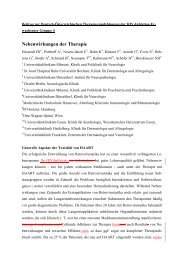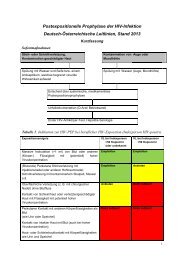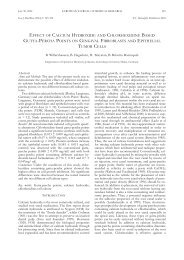European Journal of Medical Research - Deutsche AIDS ...
European Journal of Medical Research - Deutsche AIDS ...
European Journal of Medical Research - Deutsche AIDS ...
Create successful ePaper yourself
Turn your PDF publications into a flip-book with our unique Google optimized e-Paper software.
68 EUROPEAN JOURNAL OF MEDICAL RESEARCH<br />
June 27, 2007<br />
ing malignant disease was observed. These trends should be<br />
examined in a larger cohort.<br />
B.40 (Poster)<br />
Incidence <strong>of</strong> gastritis in patients presenting before<br />
and after 1996 and the role <strong>of</strong> ART.<br />
A retrospective analysis <strong>of</strong> the AVK cohort<br />
Traeder C.E. 1 , Kowol S. 1 , Masuhr A. 1 , Arastéh K. 1 ,<br />
Kompetenznetz HIV/<strong>AIDS</strong> Deutschland<br />
1 Vivantes Auguste-Viktoria-Klinikum Berlin, Infektiologie,<br />
Berlin, Germany<br />
HIV patients have been treated in the Vivantes Auguste-Viktoria-Klinikum<br />
(AVK) Berlin since 1985. The total number<br />
<strong>of</strong> episodes <strong>of</strong> treatment amounts to 15228 until the end <strong>of</strong><br />
2006, with 5368 different patients and a constant number <strong>of</strong><br />
750-850 patients/years. Gastritis is a constant problem in<br />
patients presenting with HIV infection. The reason for this<br />
is not clear and the role <strong>of</strong> HAART is discussed controversially.<br />
Methods: We compared the number <strong>of</strong> gastritis found in endoscopic<br />
examinations and correlated these results to the HIV<br />
therapy taken by the investigated patients. The analysis was<br />
done by a retrospective analysis <strong>of</strong> the electronic data base <strong>of</strong><br />
the department <strong>of</strong> infectiology. Data were analysed for the<br />
years 1994- 1996 (853 gastroscopies) and the years 2004 –<br />
2006 (1159 gastroscopies). Gastritis, which in this presentation<br />
is not being differentiated into gastritis a, b or c, was diagnosed<br />
endoscopically or histopathologically. Recurrent patients<br />
were counted.<br />
Results: 1994 – 1996: 853 gastroscopies, gastritis 327/38.3%<br />
(included 71 patients with CMV gastritis). These 327 patients<br />
could be divided in the group with NRTI (42, 12,8%) and the<br />
group without NRTI (285, 87,2%). None <strong>of</strong> the patients got PI<br />
or NNRTI, study medication not detected.<br />
2004 – 2006: 1159 gastroscopies, gastritis 422/36.4% (included<br />
36 patients with CMV gastritis). These 422 patients<br />
could be divided in the group <strong>of</strong> combination therapy with<br />
NNRTI or PI (249, 59.0%) and without combination therapy<br />
(173, 41.0%). ART in the years 2004 – 2006: 2764 stays,<br />
1549 (56.0%) on HAART, 1215 (44.0%) without HAART.<br />
1549 Patients on HAART divided in NNRTI group (459, 29.6<br />
%) and PI group (1090, 70.4%).<br />
NNRTI versus PI combination and gastritis: total number <strong>of</strong><br />
gastritis and HAART: 249, use <strong>of</strong> NNRTI 76, 30.5%, use <strong>of</strong><br />
PI 161, 64.6 %, use <strong>of</strong> NNRTI and PI 12, 4.8%.<br />
Discussion: We did not observe an increase in gastritis since<br />
1996. The percentage <strong>of</strong> 38% in the first period is comparable<br />
with 36% <strong>of</strong> the second period. The use <strong>of</strong> HAART in the second<br />
period is much higher (60% versus 12%) and reflects the<br />
availability <strong>of</strong> combination therapy. There is no difference between<br />
NNRTI or PI combination therapy (compared use <strong>of</strong><br />
NNRTI or PI / all patients with use <strong>of</strong> NNRTI or PI / gastritis<br />
patients).<br />
B.41 (Vortrag)<br />
Die Primäre HIV-Infektion: Grundlagen,<br />
Diagnostik und Behandlung<br />
Jessen H. 1<br />
1 Gemeinschaftspraxis Jessen/Jessen/Stein, Berlin, Germany<br />
Die Primäre HIV-Infektion (PHI) wird definiert als der<br />
Zeitraum zwischen dem Eintritt des Virus in die lokalen<br />
Zielzellen und dem Abschluss der Serokonversion. Es ist<br />
schwierig, dieses akute Stadium der HIV-Infektion zu erkennen<br />
– und dennoch ist eine frühe Diagnose von großer<br />
Bedeutung: Es gibt zunehmend Anzeichen dafür, dass eine<br />
während dieser Phase einsetzende Behandlung den Verlauf<br />
der Krankheit ändern und in virologischer, immunologischer<br />
und klinischer Hinsicht von Vorteil sein kann. Auch<br />
wenn uns nur wenige Ergebnisse von kontrollierten Studien<br />
zur Verfügung stehen, ist der potentielle Nutzen einer<br />
Behandlung von PHI doch dem bekannten Risiko von<br />
Nebenwirkungen bei Langzeitbehandlung und der Resistenzentwicklung<br />
gegenüberzustellen. Eine frühest mögliche<br />
Identifizierung eines Patienten mit PHI ist darüber<br />
hinaus wichtig, um eine deutlich einfachere Übertragung<br />
von HIV-1 in dieser Phase mit sehr hoher Virämie zu verhindern.<br />
B.42 (Vortrag)<br />
6 year-outcome in 20 HIV-1 positive children<br />
treated with 2 nucleoside reverse transcriptase<br />
inhibitors + Nelfinavir as first line protease<br />
inhibitor<br />
Hien S. 1 , Buchholz B. 1 , Beichert M. 2 , Duerken M. 1 ,<br />
Schaible T. 1<br />
1 Universitätskinderklinik Mannheim, Mannheim, Germany,<br />
2 Universitätsfrauenklinik Mannheim, Mannheim, Germany<br />
Purpose: Because only few data about long term outcome <strong>of</strong><br />
HIV-1-infected children treated with Nelfinavir (NFV) as<br />
first line protease inhibitor (PI) exist, a retrospective analysis<br />
<strong>of</strong> antiviral activity and safety in these children was performed.<br />
Methods: 20 PI-naive children, who were treated with 2 nucleoside<br />
reverse transcriptase inhibitors (NRTI) + NFV between<br />
Oct 1997 – Jan 2007 were analysed. According to<br />
CDC-classification 7 children were classified as stage A1-2,<br />
6 as B1-2, 3 as B3 and 4 as C3 at start <strong>of</strong> NFV. 10 had a HIV-<br />
1 viral load (VL) 1Mio. copies/ml. All children received NFV as<br />
whole, halved or crushed tablets (dissolved in water) in a<br />
dosage <strong>of</strong> initially 3x 30mg/kg and after 1999 <strong>of</strong> 2x 60-<br />
65mg/kg.<br />
Results: In the table the proportions <strong>of</strong> patients with HIV1-<br />
VL less than 400 copies/ml by on-treatment - versus intent-totreat<br />
analysis are shown (Table 1).<br />
Table 1


